Table of Contents
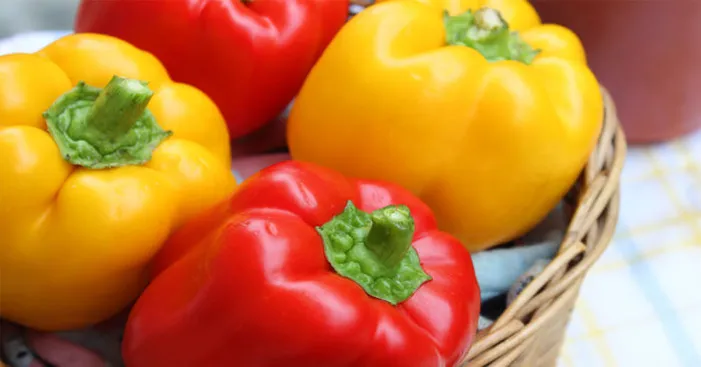
Have you ever wondered if bell peppers are a fruit or a vegetable? Well, the answer may surprise you.
Bell Pepper is actually a fruit!
Yes, you heard it right!
Bell peppers are a type of fruit that is packed with essential vitamins and minerals, making them a nutritious addition to any diet.
Whether you’re looking to add flavor to your favorite recipes or just want to know what makes bell peppers so special, this blog post will tell you everything you need to know about this unique fruit.
Bell pepper is a fruit!
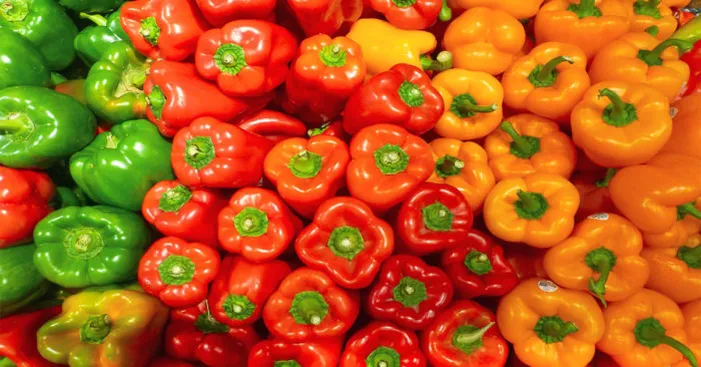
Bell pepper, also called “cold pepper”, is sweet and not as spicy as the classical flavor of peppers.
It belongs to the Solanaceae family and goes by the scientific name Capsicum annum.
They come in heart shapes and different colors including green, yellow, orange, white, red, and purple.
Generally, chilies, Jalapeno, Serrano, Habanero… all peppers are yummy as some tickle your taste buds and others taste sweet and refreshing.
However, it is very confusing to tell if bell peppers are fruits or vegetables!
Technically speaking, we can only reply to this question based on different views.
The classification of bell peppers differs from nutritionists to scientists and kitchen chefs.
Plant classification: bell pepper is a fruit
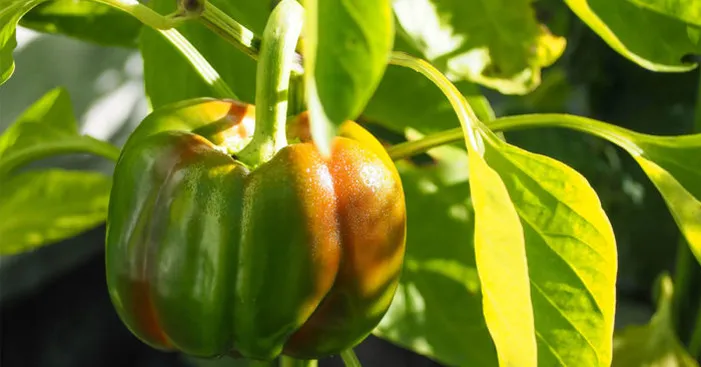
Scientists (more specifically botanists) use plant taxonomy, which is the science of classifying plants.
They tend to study the physiological parts of the plant based on its structure, regulation, and function.
Usually, a plant is considered a fruit when it produces seeds.
As it forms, it grows from the ovary, then it flowers and produces seeds that becomes fruits.
By this scientific definition, bell pepper is a fruit that grows from seeds that starts from flowers.
On the other hand, using this same science, there is no clear definition of “vegetables”.
This is because we call vegetable any edible part of the plant from roots, leaves, stems …
Nonetheless, from a botanical perspective bell peppers are just like tomatoes: they are fruits!
Kitchen classification: bell pepper is a vegetable
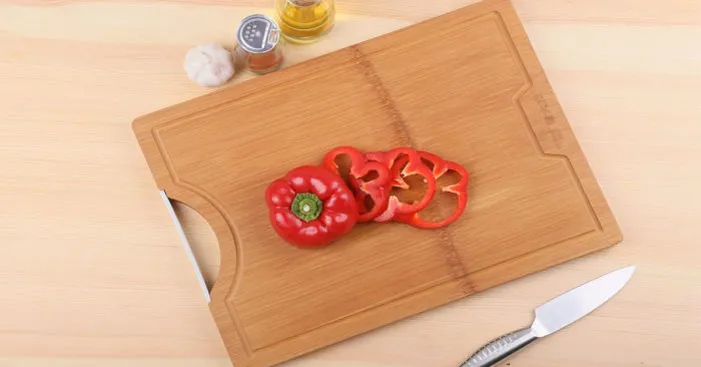
Nutritionists, cooks, and even your grandma will use the kitchen classification which is different from plant science.
In this case, they classify fruits and vegetables based on the way they use them and their texture.
For instance, they believe that vegetables usually need to be cooked in dishes such as soups and stews…
As for fruits, they have a soft texture a sweet and acidic flavor, and are often used in sweet dishes.
As for the use, they usually use bell peppers in savory dishes which is why they classify them as vegetables.
Bell peppers: fruits vs vegetables
So why all of this confusion?
Both definitions serve the purpose intended for them!
For plant scientists, classifying bell peppers as fruits serve them in their researches and discoveries.
In fact, it helps them to identify different species of peppers and other related plants and understand how to grow them…
On the other hand, the kitchen classification is useful to cooking experts.
For instance, foods from the same plant family don’t necessarily have the same nutritional values.
For example, pumpkins, cucumbers, and watermelons belong to the same plant family but have completely different tastes.
Also, avocados, pumpkins, tomatoes, bananas, and bell peppers are fruits considered vegetables.
Summary: Bell pepper is both fruit and vegetable:
To sum things up, even though bell peppers are fruits, we mostly use them as vegetables in a soup or a fried dish.
This is why from a cooking point of view, we may consider them as vegetables.
However, who cares as long as these peppers are delicious we can all agree that they are a healthy and yummy ingredient in our diets.
How many calories and health benefits in a bell pepper?
Calories in a bell pepper:
This data counts for the recommended serving of 5 ounces (150g) of bell peppers (1 bell pepper):
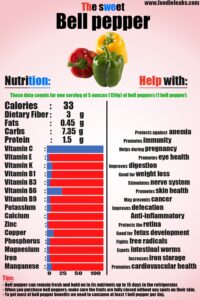
- Calorie: 33
- Fibers: 3g
- Fats: 0.45g
- Carbs: 7.35g
- Protein: 1.5g
- C vitamin: 140%
- E Vitamin: 4.5%
- K vitamin: 10%
- B1 vitamin: 9%
- B3 vitamin: 6%
- B6 vitamin: 27%
- B9 vitamin: 6%
- Potassium: 7.5%
- Calcium: 3%
- Zinc: 3%
- Copper: 12%
- Phosphorus: 6%
- Magnesium: 4.5%
- Iron: 6%
- Manganese: 9%
Health benefits in a bell pepper:
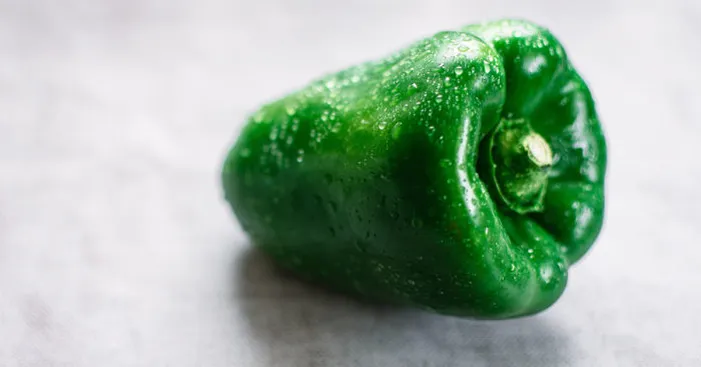
There are many health virtues that come with bell pepper, which probably will make you want to eat it more often.
Among these benefits we mention:
Protects against anemia:
One of the main causes of anemia is a deficiency in Iron, which usually leads to a feeling of weakness and fatigue.
Bell pepper is not only a great source of Iron, but it also contains 5 times more vitamin C than oranges.
Among the many roles of vitamin C, it increases the absorption of Iron in the intestines.
Therefore, consuming food that are rich in vitamin C, such as meat and fruits increases iron storage and reduces the risk of anemia.
Promotes better immunity:
The general function of the immunity system is to protect our bodies against infections and diseases.
Another health virtue thanks to the amount of vitamin C in bell peppers is that it strengthens the immune system.
Particularly, this vitamin makes our immune system more active and alert to any possible dangers.
Helpful during pregnancy:
Scientists and nutrition specialists have all agreed that a diet rich in folic acid is beneficial for both the mom and the fetus.
By eating just one bell pepper, a pregnant woman can get up to 20% of her daily need for folic acid.
However, the only diet a pregnant woman should follow is the one recommended by her own doctor.
Promotes eye health:
Usually, eyes are very vulnerable to aging and inflammation which are the reason for most eye issues.
As we all know, what you eat definitely has an effect on your overall health as you grow older.
Bell peppers also come with an abundance of antioxidants, minerals, and vitamins which promote a better sight.
Specifically, these nutrients protect the retina from oxidative stress.
Several studies also showed that consuming food rich in carotenoids reduces the risk of developing macular degeneration.
Improves digestion:
We all suffered problems related to digestion including, diarrhea, constipation, vomiting, nausea …
Nutritionists recommend including more bell pepper in the diet of people who deal with digestive issues.
It is because this pepper is a good source of Niacin (vitamin B3) which regulates the digestive process.
As a result, the body absorbs more nutrients easily and has better defecation.
Good for weight loss:
Once we consume a bell pepper, our bodies convert most of its carbs into energy instead of storing it.
Consequently, our bodies can fight the already stored carbs and help lose a few extra pounds.
So, eating more bell peppers will provide us with the calories we need without bringing additional fats.
Stimulates the nerve system:
The nerve system sends thousands if not millions of signals daily to the organs to ensure their proper functioning.
Many studies have been conducted to investigate the effect of diet on the well-being of the nerve system.
Some of these studies recommend the consumption of bell peppers as they can promote a healthier nerve system.
Promotes skin health:
Bell peppers are so full of vitamin C, which not only promotes immunity but also improves the appearance of the skin.
These skin benefits are not limited to its content in vitamin C but also in beta-carotene.
This nutrient is highly antioxidant which protects the skin from the effect of UV radiation.
Thus, regular consumption of a bell pepper helps stimulate collagen production, which keeps the skin hydrated.
As for vitamin C, it helps our skin by giving it a better resistance against skin dryness and cancer.
Cooking bell pepper:

To take advantage of all of the minerals and vitamins in bell peppers, you can practically use them in any dish.
It is one of the basic vegetables used in many classic dishes throughout the world and in all cuisines.
For instance, it is the basic element of Ratatouille (France), Piperade (Basque), Paella and Gazpacho (Spain), Caponata (Italy).
As for Hungary, bell pepper is a main ingredient in the famous Goulash dish.
Also, In North African countries they marinate bell peppers in olive oil as a side dish to lamb and chicken.
In addition, we can’t exclude bell pepper from most Latin cuisines as they are famous for the usage of chili and peppers.
However, there are several methods to cook bell peppers on their own, here are few easy methods you can try at home:
Pan-frying bell peppers:
If you like the crispiness of frying, you can pan-fry vegetables alongside bell peppers to make a yummy fried salad.
- Start by heating olive oil over medium heat, meanwhile wash your peppers then cut them into slices.
- Place the slices in the pan and fry them for about 5 minutes on each side until they look crispy.
- Make sure you stir them with a wooden spoon to avoid burns and remove them when they look soft but slightly crunchy.
Then you can add carrot slices, corn, and soy sauce to obtain a yummy Asian dish.
Baking bell peppers in the oven:
Some people like to cook bell peppers in the oven to get that roasting flavor.
To do that:
- Heat your oven to 390°F (200°C).
- In the meanwhile, wash the peppers in clean water then dry them with a towel.
- Cut the peppers in halves and remove stems and seeds.
- Now place them on a baking sheet with their skin side facing up.
- Put them in the oven for 25 to 30 minutes.
- After that time you should see some get a darker shade and have few blisters on their skin.
- Take them out and wrap them in aluminum foil and leave them to cool down for 15 minutes.
After that, it should be easy to peel the pepper then you can consume them immediately or wait for them to be cooled down.
As for stuffed peppers, cut the top part, remove the stems and fill them with rice and any meat you want.
After that put the stuffed bell pepper in the oven for 1 hour until the insides are fully cooked.
Steaming bell peppers:
This is probably the best cooking method to maintain its nutritional qualities as much as possible, then:
- First, start by washing the peppers in clean water then dry them with a clean towel.
- Then cut the peppers in strips for even cooking.
- Now place the pepper in a steamer basket.
- Fill the steamer with water and then heat it.
- Keep it steaming for 12 to 15 minutes.
- You can then enjoy them hot or drizzled with olive oil and herbs.
- Or let them cool down, then serve them with cheese and few olives.
Cooking bell peppers in the microwave:
This next method is perfect if you are in a hurry and want to eat bell pepper but you don’t have time for cooking.
- Just wash your peppers, dry them with a towel, remove the seeds, and cut them into strips.
- After getting your pepper strips ready, place them in a glass dish with 2 tbsp. of water and cover them with cooking sheets.
- Place the glass dish in the microwave at maximum temperature for 2 minutes and stir halfway through cooking.
- Finally, you can enjoy them hot with seasoning, or left to cool down then added to a mixed salad.
Precautions to take when eating bell peppers:

There is a general concept that eating too much of anything can cause several side effects.
This is not an exception for bell peppers, they are very nutritious but eating too much is probably not a good idea!
However, in this part, we are going to focus on a rare allergy that some people suffer from.
Yes, some people may be allergic to peppers and experience several symptoms once they eat them.
Among those allergic reactions they can suffer from:
- Itching,
- Rash.
- Vomiting.
- Bloating.
- Stomachache.
- Diarrhea.
Usually, people who have a pollen allergy are more likely to have an allergy to pepper as well.
In extremely rare cases, some people develop an allergy to vegetables among the Solanaceae family, which includes bell pepper.
This type of allergy is linked to problems in the respiratory system that can be shortness of breath or asthma.
Buying bell peppers:
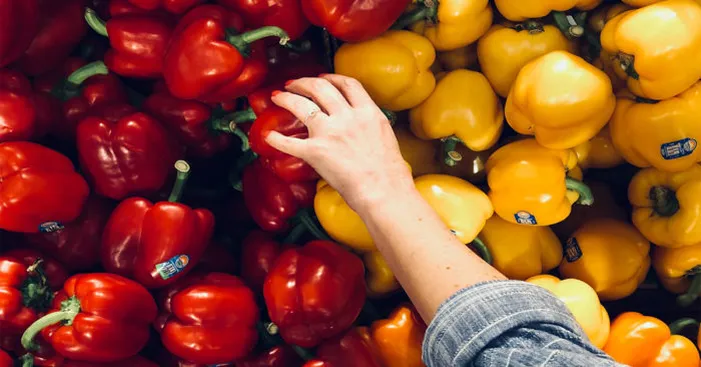
Whether they are green, yellow, or red, bell pepper’s color depends on their ripeness.
This fruit always starts green in the plant, then as much as it ripens it changes colors to yellow, then orange then red.
Basically, the more it’s left in the plant the more it changes colors, however, it can be consumed green as well.
Green bell peppers tend to have a more bitter flavor than when it’s red and fully ripened.
Depending on the color you want on your plate, purchase any pepper you want as they all taste peppery and refreshing.
However, the real taste of a bell pepper is that of the red colored ones are the most fully ripen of all the peppers.
As for the green ones, they have an interesting flavor like a mixture of the classic bell pepper taste with a little bitterness.
In terms of prices, usually yellow and red bell peppers are more expensive and have a sweeter flavor.
With all the colors of this type of pepper, it can be confusing to pick the fresh ones, but you should trust yourself and your hands!
The only thing you need to do is to make sure the fruit is fully closed without any spots on its skin.
Storing bell peppers:

There is no doubt that bell pepper is a fruit full of nutrients, but to preserve its benefits you need to:
Store it in the refrigerator:
The perfect bell pepper to store in the refrigerator should have a bright color with no stems.
When you purchase fresh bell peppers, make sure you remove any stems attached and place them in the crisper.
These peppers can remain fresh and hold on to their nutrients for up to 15 days in the refrigerator.
Store it in the freezer:
To keep a bell pepper fresh for a longer period or out of its season, you can freeze it.
Start by washing the them in clear water, to remove any parasites.
You can then dry them with a towel so they don’t stick together in the freezer.
Then place them on the lower shelf of a refrigerator for 2 hours to avoid temperature shock.
After that, take them out, and place them in airtight seal bags, and put them in the freezer.
By doing that, bell peppers will remain edible for up to 6 months.
However, when it is time to use them, take them out of the freezer and put them in the refrigerator for 24 hours before using them.
